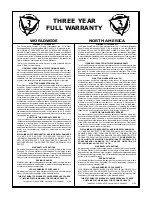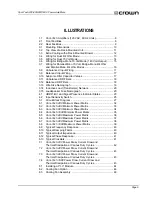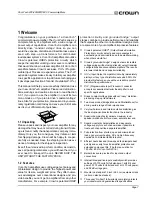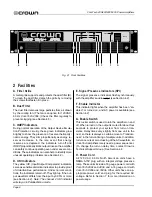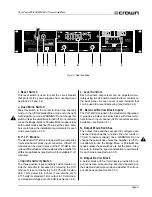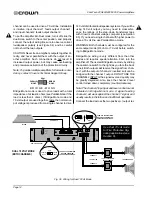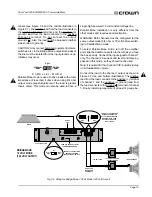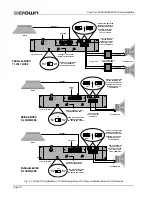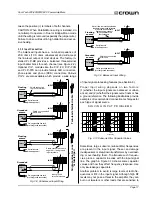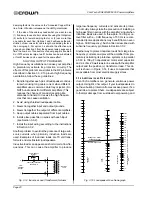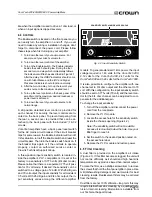
Page 11
Com-Tech 200/400/800/1600 Power Amplifiers
than 400 btu (100 kcal) per hour per unit will need ad-
ditional cooling. If you want to test your amplifier for
sufficient cooling in the real world, an easy way is to
observe the
ODEP indicators while the amplifier is op-
erating under worst-case conditions. If the indicators
dim, additional cooling is recommended.
There are at least three ways to provide extra cooling
for an amplifier that does not have an internal fan. The
most effective method is to install an internal fan which
is available from Crown as an accessory (see Sec-
tion 8.2). If you know in advance that an internal fan is
needed, you can order the
Com-Tech 200BF which in-
cludes a factory-installed fan.
A rack-mounted blower or an air conditioner can also
be used to provide extra cooling. In some situations,
you may find it practical to use these methods without
installing a fan in each amplifier. However, we gener-
ally recommend that you use the internal fans because
they provide the most efficient cooling, and are active
only when needed. Amplifiers that already have inter-
nal fans can also take advantage of a rack-mounted
blower or air conditioner, so these approaches will be
discussed in the section that follows.
3.2.2 Additional Cooling for Units with Internal Fans
If multiple amplifiers will be operated under demand-
ing conditions (such as driving loads less than
4 ohms), or if air flow through the rack will be restricted,
you should verify that the total air flow through the rack
will be sufficient. As described in Section 3.2.1, suffi-
cient air flow can be tested in the real world by observ-
ing the
ODEP indicators while operating under
worst-case conditions. If the indicators dim, cooling
can be improved by reducing air restrictions, installing
a rack-mounted blower, or using an air conditioner.
Many things can cause air flow restrictions, including
improper mounting, bunched up power cords, closed
rack doors, and clogged dust filters. A
Com-Tech am-
plifier should be mounted in a way that allows sufficient
air flow into the front intakes, out the side exhaust
vents, and out the back of the rack. If your rack has a
front door, it is usually best to leave it open and avoid
blocking the air intakes. If this is impossible, supple-
ment the air flow by mounting a grille in the door or with
a rack-mounted blower. If you install a grille in the door,
we recommend wire grilles over perforated panels be-
cause wire tends to cause less air restriction (perfo-
rated panels cause a minimum air restriction of 40%).
A better choice for increasing the air flow behind a
rack cabinet door is to use a “squirrel cage” blower.
AIR
FLOW
AIR FLOW
RACK
CABINET
16 in
40.6 cm
2 in
(5 cm)
MIN.
17 in
43.2 cm
AIR
FLOW
AMPLIFIER
(TOP VIEW)
IMPORTANT: Be sure the back of
the amplifier is supported.
Fig. 3.2 Top View of a Rack-Mounted Unit
affects output power also affects the required air flow.
Average output power is mainly affected by three
things: (1) duty cycle of the input signal, (2) load im-
pedance, and (3) rated output power. First, as the duty
cycle of the input signal increases, the average output
power level increases. For example, the amplifier will
need more air flow with a rock ‘n’ roll input signal than
with infrequent paging. Second, as the load imped-
ance of a connected loudspeaker gets smaller, more
current will flow across the load which effectively in-
creases output power. This means you can expect the
amplifier to require more air flow with a 2 ohm load than
with a 4 ohm load. Finally, an amplifier that is rated for
higher power output is usually used at higher average
output levels. So a
Com-Tech 1600 delivering full out-
put will require more air flow than a
Com-Tech 200.
These relationships and the resulting thermal dissipa-
tion levels are defined mathematically in Section 7.
3.2.1 Cooling for Units without Internal Fans
All units have a three-speed on-demand cooling fan
except for the North American
Com-Tech 200. Forced-
air cooling may not be needed for applications with a
low duty cycle such as paging or background music.
This is why the North American
Com-Tech 200 is
usually provided without a fan.
If you will be using a North American
Com-Tech 200 in
a high temperature environment, or at full power for
sustained periods, you can anticipate that additional
cooling will be needed. It may also be helpful to use
the information in Section 7 to estimate the amplifier’s
thermal dissipation for your application. In general, a
North American
Com-Tech 200 that dissipates more


